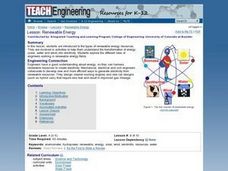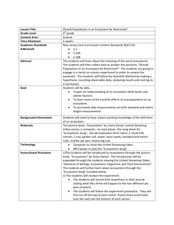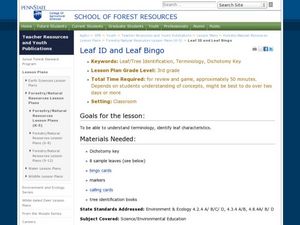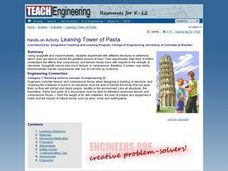Curated OER
Bird Buffet
Fifth graders investigate how birds use their beaks. In this agriculture lesson, 5th graders use tools to simulate how birds gather food with their beaks. They then draw conclusions about certain types of beaks and what types of food a...
Curated OER
Oil Spill
Students explore an important role of environmental engineers by studying the Exxon Valdez oil spill. They experiment with different strategies in order to clean up their own manufactured oil spill.
Curated OER
It's Really Heating Up in Here!
Students create and observe a greenhouse effect model and discuss the implications of global warming theory for engineers, themselves and the Earth. They discover that Global warming is becoming an increasing concern as we learn more...
Curated OER
Recycling
Learners relate recycling to waste reduction. In this science lesson, students talk about the environment and how recycling certain natural resources actually saves on energy. They also discuss what type of recycling causes pollution...
Curated OER
TE Lesson: Energy Transfer in Musical Instruments
Students study concepts of energy and energy transfer. They look at how these concepts apply to musical instruments. They study the law of conservation of energy. They use the concepts studied in the lesson plan to design a musical...
Curated OER
Let's Heat Things Up!
Students build and evaluate simple models to understand the greenhouse effect. They explore the role of increased greenhouse gas concentration in global warming, and the implications of global warming theory for engineers, themselves...
Curated OER
TE Lesson: Renewable Energy
Students examine renewable energy sources such as solar, water, and wind. They experiment to determine how renewable energy is transformed into electricity. They investigate the role of engineers who work in the field of renewable energy.
Curated OER
A Constructivist Version of the Snail & Elodea Lab
Students explain the importance of having a control when setting up an experiment.
Curated OER
The Sahara: Home of the Tuareg
Students study inhabitants of the Sahara. In this Tuareg culture lesson, students explore the how the Tuareg people adapt to their environment as they research specific Internet sites.
Curated OER
What Does it Take to be a Survivor? Part One
Young scholars explore marine animal adaptation. In this introductory ocean life biology instructional activity, students access prior knowledge by participating in a whole class "thought swap." Young scholars form two lines, respond to...
Curated OER
Wasting Energy at Home
Students act as energy conservation engineers and identify the ways energy is conserved or wasted. They also discover many ways to personally conserve energy everyday. Students discover how engineers perform home energy audits to...
Curated OER
Ocean Life
Students explore the topics of ocean water salinity, ocean life zones, marine life classification, and ocean food chains. They observe demonstrations, conduct experiments, complete quizzes and handouts, and analyze key vocabulary.
Curated OER
The Physics of Sound: How We Produce Sounds
Students are introduced to how they produce sounds. In groups, they participate in experiments in which they measure sound and identify their five senses. Individually, they make their own musical instruments using different objects and...
Curated OER
Should Populations in an Ecosystem be Restricted?
Fourth graders experiment to determine how overpopulation effects ecosystems specifically plants. In this ecosystem lesson, 4th graders conduct an ecosystems experiment after listening to Claire Daniel's, Ecosystems. They watch a video,...
Curated OER
Intertidal Zones
Students explore intertidal zones. In this intertidal zones lesson plan, students work in small groups and use ready-made materials to create a model of intertidal zones. Resources are provided.
Curated OER
Dripping Wet or Dry as a Bone?
Students use a sponge and water model to explore the concept of relative humidity and create a percent scale. They define humidity and saturation, build a simple humidity/saturation model, collect, predict and interpret data, and create...
Curated OER
Leaf ID and Leaf Bingo
Third graders explore the parts of a leaf and use a dichotomy key to identify leaves. In this biology lesson, learners study characteristics of various leaves and play a game of bingo to identify leaves by their traits. Students find and...
Curated OER
Konnecting Simple Machines and K'Nex
Students study and identify different types of simple machines and how they work. They design a simple machine.
Curated OER
Plants and Animals
Students find common needs between plants and animals. In this plants and animals lesson students compare that both plants and animals need food and water. They also find the differences between plant and animal needs.
Curated OER
What's Air Got to Do with It?
Young scholars use M&M's to create a pie graph that expresses their understanding of the composition of air. They watch and conduct several simple experiments to develop an understanding of the properties of air (it has mass, it...
Curated OER
Greenewables
Learners form expert engineering teams working for the (fictional) alternative energy consulting firm, Greenewables, Inc. Each team specializes in a form of renewable energy used to generate electrical power: passive solar, solar...
Curated OER
Leaning Tower of Pasta
Students experiment with different structures to determine which ones are able to handle the greatest amount of load using spaghetti and marshmallows. They discuss how engineers design buildings, construct their buildings and complete a...
Curated OER
TE Activity: Trash Talkin'
Young scholars collect and categorize solid waste produced in the classroom. They weigh the waste that has been collected over one week's time, and separate it into recyclable and non-recyclable waste. They talk about the role of...
Curated OER
Investigative Case - Protistan Tales of Atlantic White Cedar Swamps
Students use this WebQuest to explore the vast diversity of microbes, especially those microbes of the Atlantic Cedar Swamps. They tell a story about the protests of the Atlantic Cedar Swamp in the form of anthropomorphism.

























